Rocket is a type of engine that pushes itself forward or upward by producing thrust. Unlike a jet engine, which draws in outside air, a rocket engine uses only the substances carried within it. As a result, a rocket can operate in outer space, where there is no air. A rocket can produce more power for its size than any other kind of engine. For example, the main rocket engine of the space shuttle weighed only a fraction as much as a train engine, but it would take 39 train engines to produce the same amount of power. The word rocket can also mean a vehicle or object driven by a rocket engine.

Rockets come in a variety of sizes. Some rockets that shoot fireworks into the sky measure less than 2 feet (60 centimeters) long. Rockets 50 to 100 feet (15 to 30 meters) long serve as long-range missiles that can be used to bomb distant targets during wartime. Larger and more powerful rockets lift spacecraft, artificial satellites, and scientific probes into space. For example, the Saturn V rocket that carried astronauts to the moon stood about 363 feet (111 meters) tall.
Rocket engines generate thrust by expelling gas. Most rockets produce thrust by burning a mixture of fuel and an oxidizer, a substance that enables the fuel to burn without drawing in outside air. This kind of rocket is called a chemical rocket because burning fuel is a chemical reaction. The fuel and oxidizer are called the propellants.
A chemical rocket can produce great power, but it burns propellants rapidly. As a result, it needs a large amount of propellants to work for even a short time. The Saturn V rocket burned more than 560,000 gallons (2,120,000 liters) of propellants during the first 23/4 minutes of flight. Chemical rocket engines become extremely hot as the propellants burn. The temperature in some engines reaches 6000 °F (3300 °C), much higher than the temperature at which steel melts.
Jet engines also burn fuel to generate thrust. Unlike rocket engines, however, jet engines work by drawing in oxygen from the surrounding air. For more information on jet engines, see Jet propulsion.
Researchers have also developed rockets that do not burn propellants. Nuclear rockets use heat generated by a nuclear fuel to produce thrust. Ion rockets, expel ions (electrically charged particles) to produce thrust.
Military forces have used rockets in war for hundreds of years. In the 1200’s, Chinese soldiers fired rockets against attacking armies. British troops used rockets to attack Fort McHenry in Maryland during the War of 1812 (1812-1815). After watching the battle, the American lawyer Francis Scott Key described “the rocket’s red glare” in the song “The Star-Spangled Banner.” During World War I (1914-1918), the French used rockets to shoot down enemy observation balloons. Germany attacked London with V-2 rockets during World War II (1939-1945). In the Persian Gulf War of 1991 and the Iraq War (2003-2011), United States troops launched rocket-powered Patriot missiles to intercept and destroy Iraqi missiles.
Rockets are the only vehicles powerful enough to carry people and equipment into space. Since 1957, rockets have lifted hundreds of artificial satellites into orbit around Earth. These satellites take pictures of Earth’s weather, gather information for scientific study, and transmit communications around the world. Rockets also carry scientific instruments far into space to explore and study other planets. Since 1961, rockets have launched spacecraft carrying astronauts and cosmonauts into orbit around Earth. In 1969, rockets carried astronauts to the first landing on the moon. In 1981, rockets lifted the first space shuttle into Earth orbit.
How rockets work
Rocket engines generate thrust by putting a gas under pressure. The pressure forces the gas out the end of the rocket. The gas escaping the rocket is called exhaust. As it escapes, the exhaust produces thrust according to the laws of motion developed by the English scientist Isaac Newton. Newton’s third law of motion states that for every action, there is an equal and opposite reaction. Thus, as the rocket pushes the exhaust backward, the exhaust pushes the rocket forward. See Motion (Newton’s laws of motion).
The amount of thrust produced by a rocket depends on the momentum of the exhaust—that is, its total amount of motion. The exhaust’s momentum equals its mass (amount of matter) multiplied by the speed at which it exits the rocket. The more momentum the exhaust has, the more thrust the rocket produces. Engineers can therefore increase a rocket’s thrust by increasing the mass of exhaust it produces. Alternately, they can increase the thrust by increasing the speed at which the exhaust leaves the rocket.
Parts of a rocket
include the rocket engine and the equipment and cargo the rocket carries. The four major parts of a rocket are (1) the payload, (2) propellants, (3) the chamber, and (4) the nozzle.
The payload
of a rocket includes the cargo, passengers, and equipment the rocket carries. The payload may consist of a spacecraft, scientific instruments, or even explosives. The space shuttle’s payload, for example, was the shuttle orbiter and the mission astronauts and any satellites, scientific experiments, or supplies the orbiter carries. The payload of a missile may include explosives or other weapons. This kind of payload is called a warhead.
Propellants
generally make up most of the weight of a rocket. For example, the fuel and oxidizer used by the space shuttle accounted for nearly 90 percent of its weight at liftoff. The shuttle needed such a large amount of propellant to overcome Earth’s gravity and the resistance of the atmosphere.
Many chemical rockets use liquid hydrogen as fuel. Hydrogen becomes a liquid only at extremely low temperatures, requiring powerful cooling systems. Kerosene, another liquid fuel, is easier to store because it remains liquid at room temperature.
Many rockets use liquid oxygen, or lox, as their oxidizer. Like hydrogen, oxygen must be cooled to low temperatures to become a liquid. Other commonly used oxidizers include nitrogen tetroxide and hydrogen peroxide. These oxidizers remain liquid at room temperature and do not require cooling.
An electric or nuclear rocket uses a single propellant. These rockets store the propellant as a gas or liquid.
The chamber
is the area of the rocket where propellants are put under pressure. Pressurizing the propellants enables the rocket to expel them at high speeds.
In a chemical rocket, the fuel and oxidizer combine and burn in an area called the combustion chamber. As they burn, the propellants expand rapidly, creating intense pressure.
Burning propellants create extreme heat and pressure in the combustion chamber. Temperatures in the chamber become hot enough to melt the steel, nickel, copper, and other materials used in its construction. Combustion chambers need insulation or cooling to survive the heat. The walls of the chamber must also be strong enough to withstand intense pressure. The pressure inside a rocket engine can exceed 3,000 pounds per square inch (200 kilograms per square centimeter), nearly 100 times the pressure in the tires of a car or truck.
In a nuclear rocket, the chamber is the area where nuclear fuel heats the propellant, producing pressure. In an ion rocket, the chamber contains the electric devices used to force the propellant out of the nozzle.
The nozzle
is the opening at the end of the chamber that allows the pressurized gases to escape. It converts the high pressure of the gases into thrust by forcing the exhaust through a narrow opening, which accelerates the exhaust to high speeds. The exhaust from the nozzle can travel more than 1 mile (1.6 kilometers) per second. Like the chamber, the nozzle requires cooling or insulation to withstand the heat of the exhaust.
Multistage rockets.
Many chemical rockets work by burning propellants in a single combustion chamber. Engineers refer to these rockets as single-stage rockets. Missions that require long-distance travel, such as reaching Earth orbit, generally require multiple-stage or multistage rockets. A multistage rocket uses two or more sets of combustion chambers and propellant tanks. These sets, called stages, may be stacked end to end or attached side by side. When a stage runs out of propellant, the rocket discards it. Discarding the empty stage makes the rocket lighter, allowing the remaining stages to accelerate it more strongly. Engineers have designed and launched rockets with as many as five separate stages. The space shuttle used two stages.
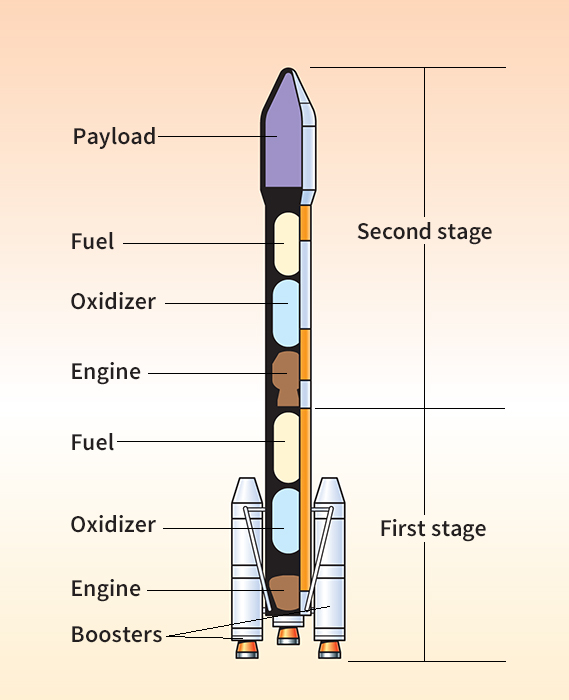
How rockets are used
People use rockets for high-speed, high-power transportation both within Earth’s atmosphere and in space. Rockets are especially valuable for (1) military use, (2) atmospheric research, (3) launching probes and satellites, and (4) space travel.
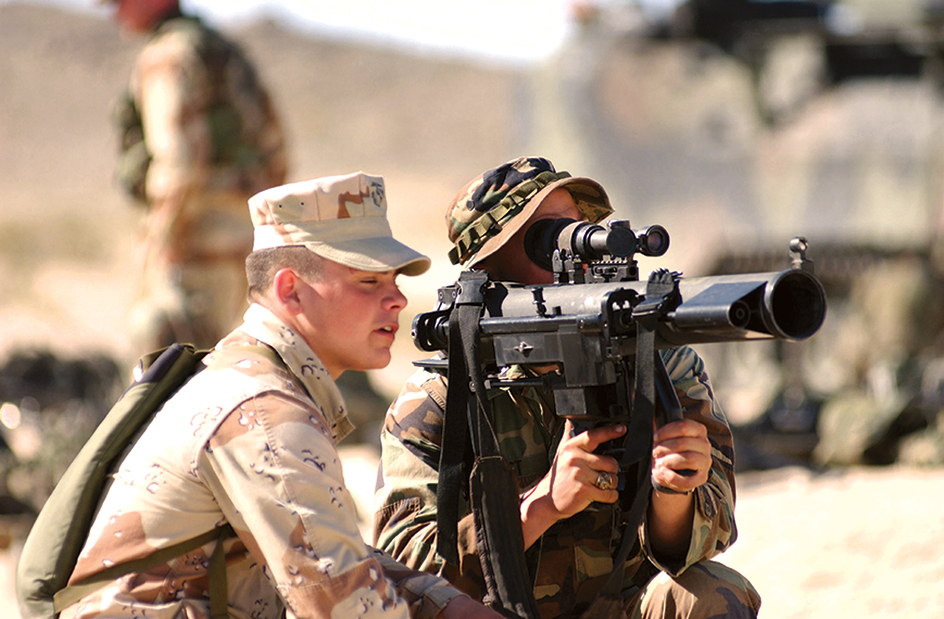
Military use.
Rockets used by the military vary in size from small rockets used on the battlefield to giant guided missiles that can fly across oceans. Soldiers often carry small, shoulder-fired rocket launchers for use against armored vehicles such as tanks. Armies use larger rockets to fire explosives far behind enemy lines and to shoot down enemy aircraft. Fighter airplanes carry rocket-powered guided missiles to attack other planes and ground targets. Navy ships use guided missiles to attack other ships, land targets, and planes.
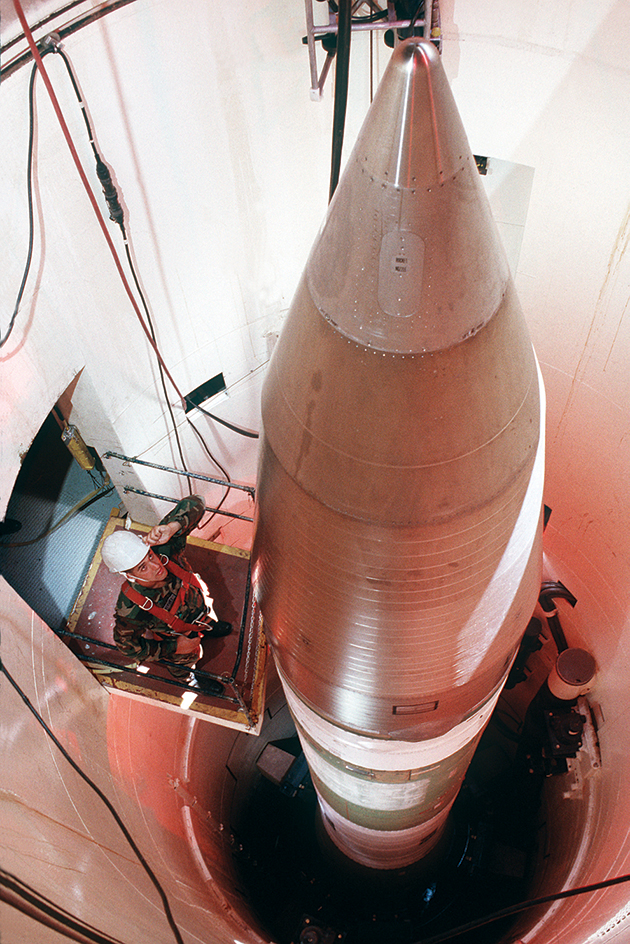
Powerful rockets propel a type of long-range guided missile called an intercontinental ballistic missile (ICBM). Such a missile can travel 3,400 miles (5,500 kilometers) or more to bomb an enemy target with nuclear explosives. An ICBM generally employs two or three separate stages to propel it during the early part of its flight. The ICBM coasts the rest of the way to its target.
Atmospheric research.
Scientists use rockets to explore Earth’s atmosphere. Sounding rockets, also called meteorological rockets, carry such equipment as barometers, cameras, and thermometers high into the atmosphere. These instruments collect information about the atmosphere and send it by radio to receiving equipment on the ground.
Rockets also provide the power for experimental research airplanes. Engineers use these planes in the development of spacecraft. By studying the flights of such planes as the rocket-powered X-1 and X-15, engineers learned how to control vehicles flying many times as fast as the speed of sound.
Launching probes and satellites.
Rockets carry crewless spacecraft called space probes on long voyages to explore the solar system. Probes have explored the sun, the moon, and all the planets in our solar system. They carry scientific instruments that gather information about the planets and transmit data back to Earth. Probes have landed on the surface of the moon, Venus, Mars, and Saturn’s moon Titan.
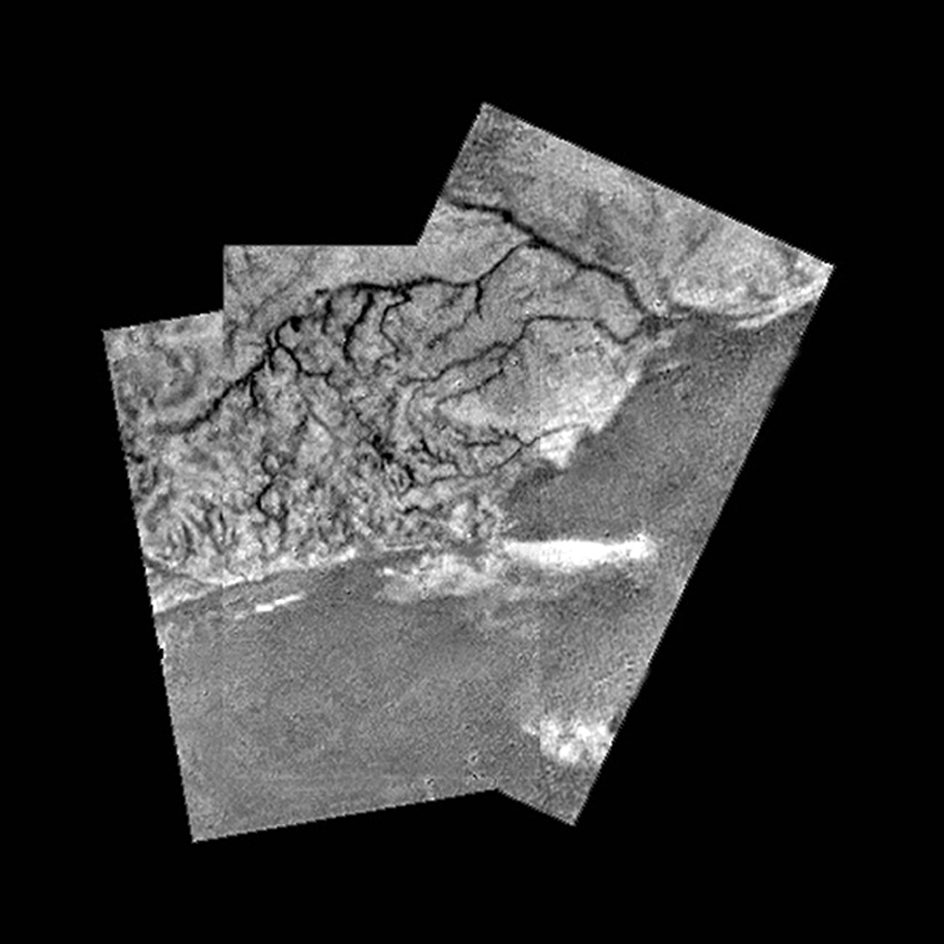
Rockets lift artificial satellites into orbit around Earth. Some orbiting satellites gather information for scientific research. Others relay telephone conversations and radio and television broadcasts across the oceans. Weather satellites track climate patterns and help scientists predict the weather. Navigation satellites, such as those that make up the Global Positioning System (GPS), enable receivers anywhere on Earth to determine their locations with great accuracy. The armed forces use satellites to observe enemy facilities and movements. They also use satellites to communicate, monitor weather, and watch for missile attacks. Not only are satellites launched by rockets, but many satellites use small rocket engines to maintain their proper orbits.
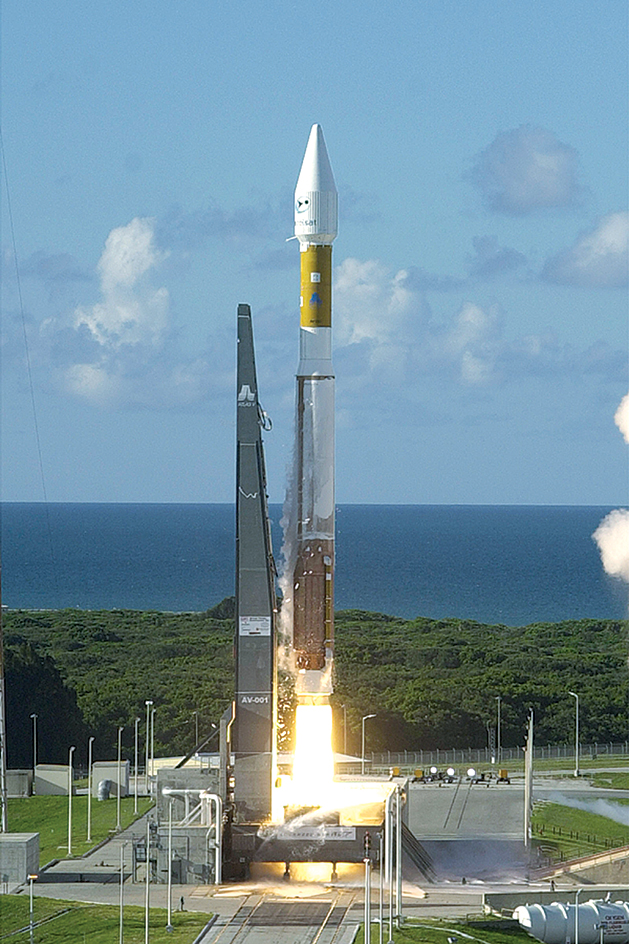
Rockets that launch satellites and probes are called launch vehicles. Most of these rockets have from two to four stages. The stages lift the satellite to its proper altitude and give it enough speed—about 17,000 miles (27,000 kilometers) per hour—to stay in orbit. A space probe’s speed must reach about 25,000 miles (40,000 kilometers) per hour to escape Earth’s gravity and continue on its voyage.
Engineers created the first launch vehicles by altering military rockets or sounding rockets to carry spacecraft. For example, they added stages to some of these rockets to increase their speed. Today, engineers sometimes attach smaller rockets to a launch vehicle. These rockets, called boosters, provide additional thrust to launch heavier spacecraft.
Space travel.
Rockets launch spacecraft carrying astronauts that orbit Earth and travel into space. These rockets, like the ones used to launch probes and satellites, are called launch vehicles.
The Saturn V rocket, which carried astronauts to the moon, was the most powerful launch vehicle ever built by the United States. Before launch, it weighed more than 6 million pounds (2.7 million kilograms). It could send a spacecraft weighing more than 100,000 pounds (45,000 kilograms) to the moon. The Saturn V used 11 rocket engines to propel three stages.
Space shuttles were reusable rocket-powered spacecraft that could fly into space and return to Earth repeatedly. The United States ended its space shuttle program in 2011. Engineers have also worked to develop space tugs, smaller rocket-powered vehicles that could tow satellites, boost space probes, and carry astronauts over short distances in orbit. For more information on rockets used in space travel, see Space exploration. 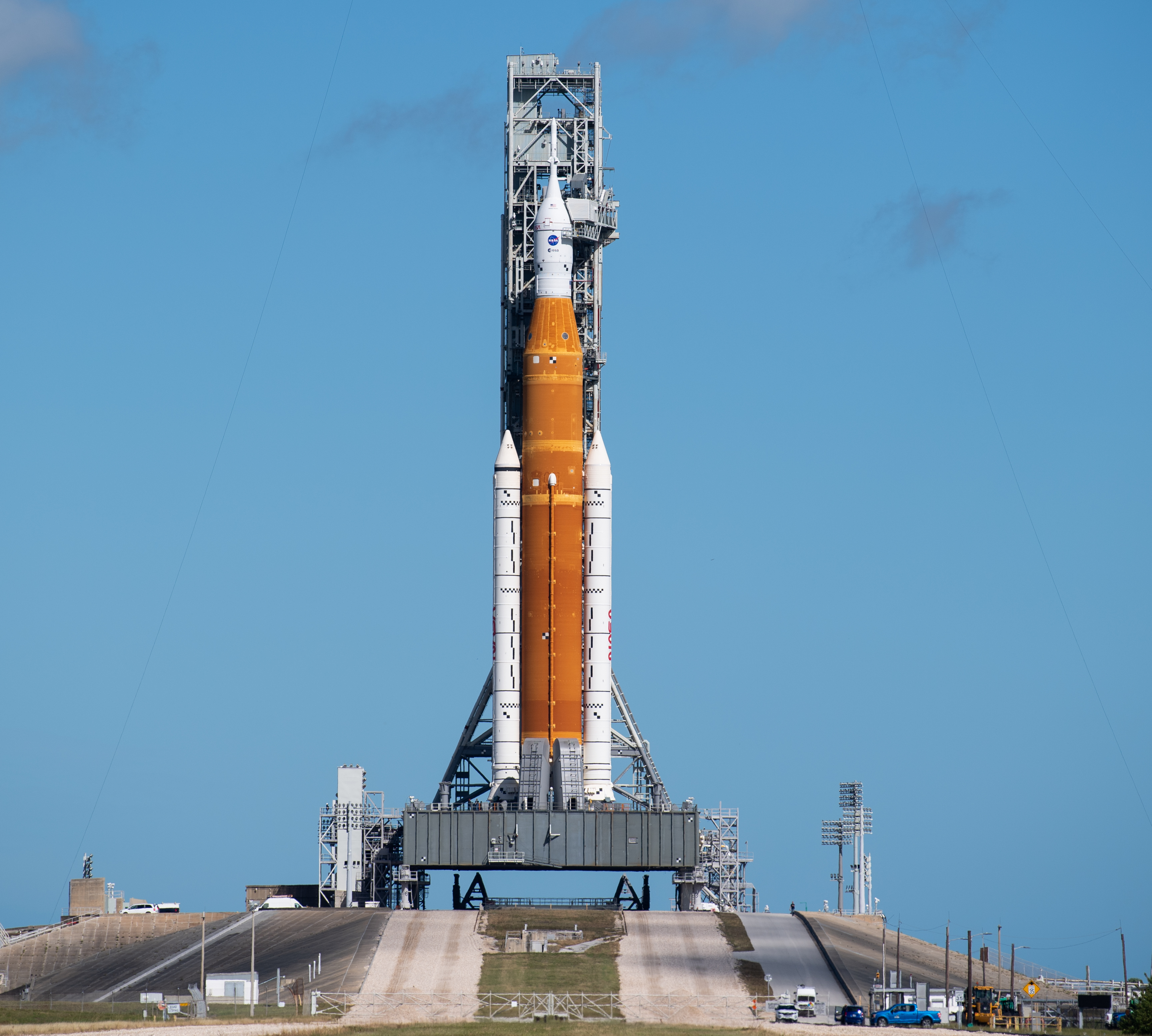
Other uses.
People have fired rockets as distress signals from ships and airplanes and from the ground. Rockets also shoot rescue lines to ships in distress. Small rockets called JATO (jet-assisted take-off) units help heavily loaded airplanes take off. Rockets have long been used in fireworks displays.
Kinds of rocket engines
The vast majority of rockets are chemical rockets. The two most common types of chemical rockets are solid-propellant rockets and liquid-propellant rockets. Engineers have tested a third type of chemical rocket, called a hybrid rocket, that combines liquid and solid propellants. Ion rockets have propelled space probes and maneuvered orbiting satellites. Researchers have designed experimental nuclear rockets.
Solid-propellant rockets
burn a rubbery or plastic-like material called the grain. The grain consists of a fuel and an oxidizer in solid form. It is shaped like a cylinder with one or more channels or ports that run through it. The ports increase the surface area of the grain that the rocket burns. Unlike some liquid propellants, the fuel and oxidizer of a solid-propellant rocket do not burn upon contact with each other. Instead, an electric charge ignites a smaller grain. Hot exhaust gases from this grain ignite the main propellant surface. 

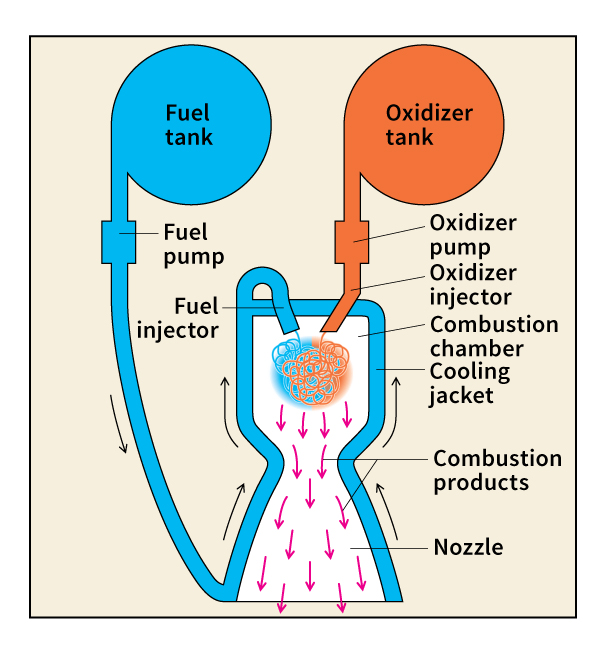
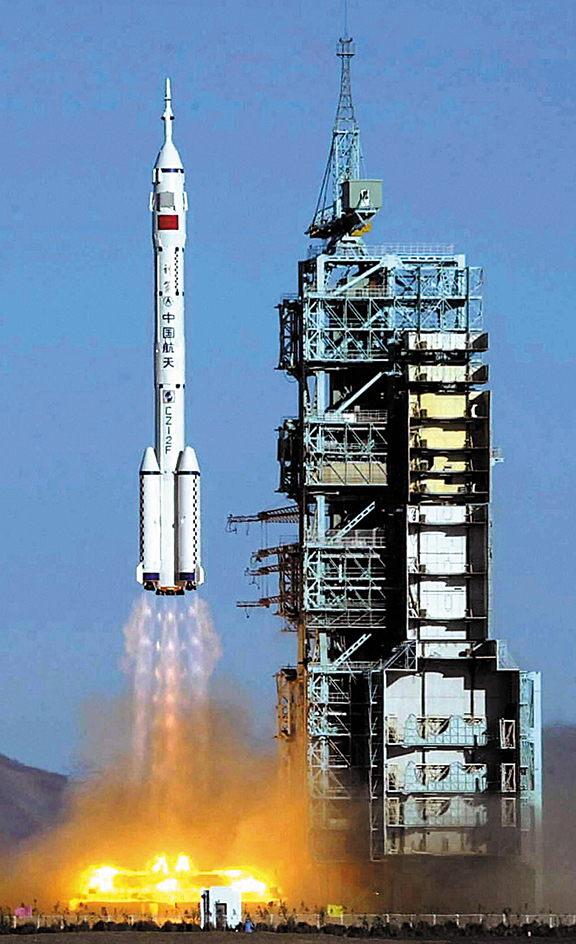
The temperature in the combustion chamber of a solid-propellant rocket ranges from 3000 to 6000 °F (1600 to 3300 °C). In most of these rockets, engineers build the chamber walls from high-strength steel or titanium to withstand the pressure and heat of combustion. They also may use composite materials consisting of high-strength fibers embedded in rubber or plastic. Composite chambers made from high-strength graphite fibers in a strong adhesive called epoxy weigh less than steel or titanium chambers, enabling the rocket to accelerate its payload more efficiently. Solid propellants burn at a rate of about 0.6 inch (1.5 centimeters) per second.
Solid propellants can remain effective after long storage and present little danger of combusting or exploding until ignited. Furthermore, they do not need the pumping and injecting equipment required by liquid propellants. On the other hand, rocket controllers cannot easily stop or restart the burning of solid propellant. This can make a solid-propellant rocket difficult to control. One method used to stop the burning of solid propellant involves blasting the entire nozzle section from the rocket. This method, however, prevents restarting.
Rocket designers often choose solid propellants for rockets that must be easy to store, transport, and launch. Military planners prefer solid-propellant rockets for many uses because they can be stored for a long time and fired with little preparation. Solid-propellant rockets power ICBM’s, including the American Minuteman III and the Russian SS-27, or Topol-M. They also propel such smaller missiles as the American Hellfire, Patriot, Sparrow, and Sidewinder. Solid-propellant rockets often serve as sounding rockets and as boosters for launch vehicles and cruise missiles. They are also used in fireworks.
Liquid-propellant rockets
burn a mixture of fuel and oxidizer in liquid form. These rockets carry the fuel and the oxidizer in separate tanks. A system of pipes and valves feeds the propellants into the combustion chamber. In larger engines, either the fuel or the oxidizer flows around the outside of the chamber before entering it. This flow cools the chamber and preheats the propellant for combustion.
A liquid-propellant rocket feeds the fuel and oxidizer into the combustion chamber using either pumps or high-pressure gas. The most common method uses pumps to force the fuel and oxidizer into the combustion chamber. Burning a small portion of the propellants provides the energy to drive the pumps. In the other method, high-pressure gas forces the fuel and oxidizer into the chamber. The gas may be nitrogen or some other gas stored under high pressure or may come from the burning of a small amount of propellants.
Some liquid propellants, called hypergols, ignite when the fuel and the oxidizer mix. But most liquid propellants require an ignition system. An electric spark may ignite the propellant, or the burning of a small amount of solid propellant in the combustion chamber may do so. Liquid propellants continue to burn as long as fuel and oxidizer flow into the combustion chamber.
Engineers use thin, high-strength steel or aluminum to construct most tanks that hold liquid propellants. They may also reinforce tanks with composite materials like those used in solid-propellant rocket chambers. Most combustion chambers in liquid-propellant rockets are made of steel or nickel.
Liquid propellants usually produce greater thrust than do equal amounts of solid propellants burned in the same amount of time. Controllers can easily adjust or stop burning in a liquid-propellant rocket by increasing or decreasing the flow of propellants into the chamber. Liquid propellants, however, are difficult to handle. If the fuel and oxidizer blend without igniting, the resulting mixture often will explode easily. Liquid propellants also require complicated pumping machinery.
Scientists use liquid-propellant rockets for most space launch vehicles. Liquid-propellant rockets serve as the main engines of Europe’s Ariane rocket, Russia’s Soyuz rocket, and China’s Long March rocket.
Hybrid rockets
combine some of the advantages of both solid-propellant and liquid-propellant rockets. A hybrid rocket uses a liquid oxidizer, such as liquid oxygen, and a solid-fuel grain made of plastic or rubber. The solid-fuel grain lines the inside of the combustion chamber. A pumping system sprays the oxidizer onto the surface of the grain, which is ignited by a smaller grain or torch.
Hybrid rockets are safer than solid-propellant rockets because the propellants are not premixed and so will not ignite accidentally. Also, unlike solid-propellant rockets, hybrid rockets can vary thrust or even stop combustion by adjusting the flow of oxidizer. Hybrid engines require only half the pumping gear of liquid-propellant rockets, making them simpler to build.
A key disadvantage of hybrid rockets is that their fuel burns slowly, limiting the amount of thrust they can produce. A hybrid rocket burns grain at a rate of about 0.04 inch (1 millimeter) per second. For a given amount of propellant, hybrid rockets typically produce more thrust than solid rockets and less than liquid engines. To generate more thrust, engineers must manufacture complex fuel grains with many separate ports through which oxidizer can flow. This exposes more of the grain to the oxidizer.
Researchers have used hybrid rockets to propel targets used in missile testing and to accelerate experimental motorcycles and cars attempting land speed records. Their safety has led designers to attempt to develop hybrid rockets for use in human flight. One such rocket would launch from an airplane to carry people to an altitude of about 60 miles (100 kilometers). Researchers have not yet developed hybrid rockets powerful enough to launch human beings into space. Hybrid rockets can produce enough thrust, however, to boost planetary probes or maneuver satellites in orbit. Hybrid rockets could also power escape mechanisms being developed for new launch vehicles that would carry crews.
The safety of hybrid rockets has led engineers to develop them for use in human flight. The Scaled Composites company of Mojave, California, developed a hybrid rocket called SpaceShipOne that launched from an airplane. On June 21, 2004, SpaceShipOne became the first privately funded craft to carry a person into space. It carried the American test pilot Michael Melvill more than 62 miles (100 kilometers) above Earth’s surface during a brief test flight. 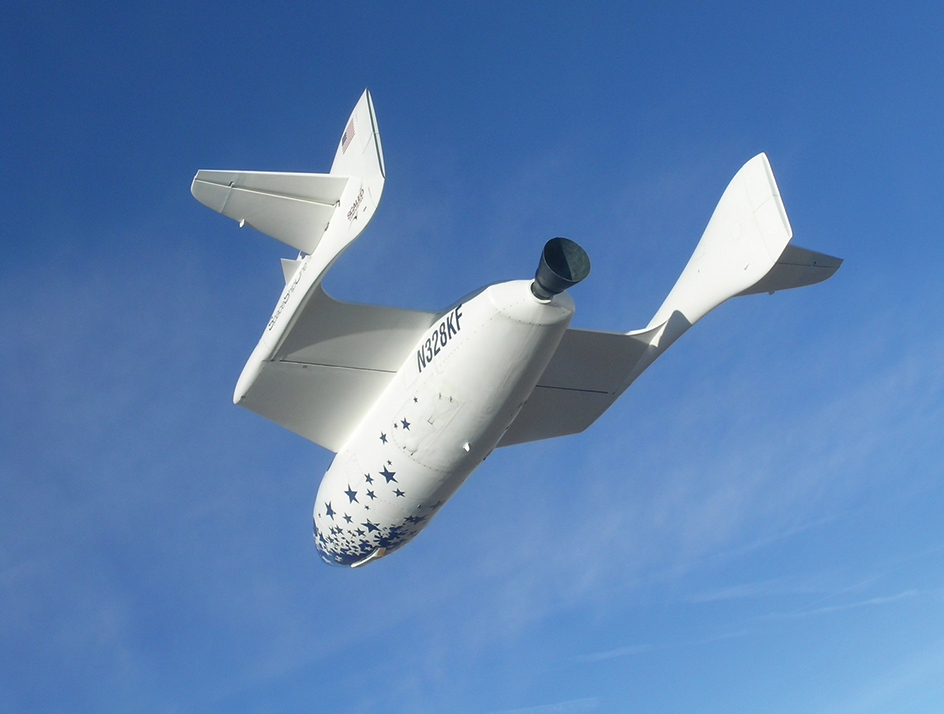
Researchers have also used hybrid rockets to propel targets used in missile testing and to accelerate experimental motorcycles and cars attempting land speed records. In addition, they have worked to develop hybrid rockets to boost planetary probes, maneuver satellites in orbit, and power crew escape mechanisms for launch vehicles.
Ion rockets
use electric energy to expel ions from the nozzle. Engineers also call this process ion propulsion. Solar panels or a nuclear reactor can provide the energy. 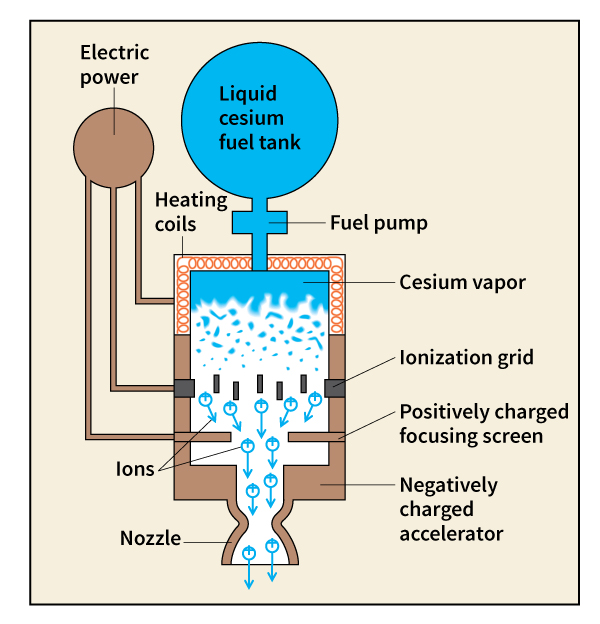
In one design, xenon gas passes through an electrified metal grid. The grid strips electrons from the xenon atoms, turning them into positively charged ions. A positively charged screen repels the ions, focusing them into a beam. The beam then enters a negatively charged device called an accelerator. The accelerator speeds up the ions and shoots them out through a nozzle.
The exhaust from such rockets travels extremely fast. However, the stream of xenon ions has a relatively low mass. As a result, an ion rocket cannot produce enough thrust to overcome Earth’s gravity. Ion rockets used in space must therefore be launched by chemical rockets. Once in space, however, the low rate of mass flow becomes an advantage. It enables an ion rocket to operate for a long time without running out of propellant. The xenon rocket that powered the U.S. space probe Deep Space 1, launched in 1998, fired for a total of over 670 days using only 160 pounds (72 kilograms) of propellant. In addition, small ion rockets using xenon propellant have provided the thrust to keep communications satellites in position above Earth’s surface.
Another type of ion rocket uses electromagnets rather than charged screens to accelerate xenon ions. This type of rocket carried the European Space Agency’s SMART-1 lunar probe to the moon in the early 2000’s.
Nuclear rockets
use the heat energy of a nuclear reactor, a device that releases energy by splitting atoms. Some proposed designs would use hydrogen as propellant. The rocket would store the hydrogen as a liquid. Heat from the reactor would boil the liquid, creating hydrogen gas. The gas would expand rapidly and push out from the nozzle. 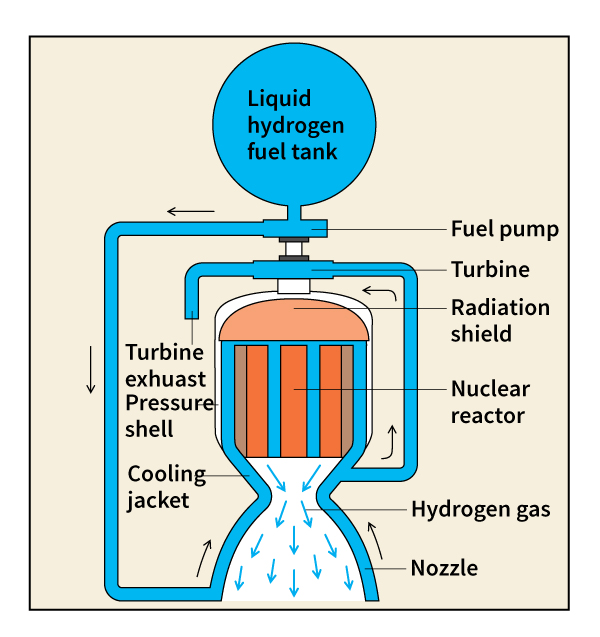
The exhaust speed of a nuclear rocket might reach four times that of a chemical rocket. By expelling a large quantity of hydrogen, a nuclear rocket could therefore achieve high thrust. However, a nuclear rocket would require heavy shielding because a nuclear reactor uses radioactive materials. The shielding would weigh so much that the rocket could not be practically used to boost a launch vehicle. More practical applications would use small nuclear engines with low, continuous thrust to decrease flight times to Mars or other planets.
Nuclear rocket developers must also overcome public fears that accidents involving such devices could release harmful radioactive materials. Before nuclear rockets can be launched, engineers must convince the public that such devices are safe.
History
Historians believe the Chinese invented rockets, but they do not know exactly when. Historical accounts describe “arrows of flying fire”—believed to have been rockets—used by Chinese armies in A.D. 1232. By 1300, the use of rockets had spread throughout much of Asia and Europe. These first rockets burned a substance called black powder, which consisted of charcoal, saltpeter, and sulfur. For several hundred years, the use of rockets in fireworks displays outranked their military use in importance.
During the early 1800’s, Colonel William Congreve of the British Army developed rockets that could carry explosives. Many of these rockets weighed about 32 pounds (15 kilograms) and could travel 13/4 miles (2.7 kilometers). British troops used Congreve rockets against the United States Army during the War of 1812. Austria, Russia, and several other countries also developed military rockets during the early 1800’s.
The English inventor William Hale improved the accuracy of military rockets. He substituted three fins for the long wooden tail that had been used to guide the rocket. United States troops used Hale rockets in the Mexican War (1846-1848). During the American Civil War (1861-1865), both sides used rockets.
Rockets of the early 1900’s.
The Russian school teacher Konstantin E. Tsiolkovsky first stated the correct theory of rocket power. He described his theory in a scientific paper published in 1903. Tsiolkovsky also first presented the ideas of the multistage rocket and rockets using liquid oxygen and hydrogen propellants. In 1926, the American rocket pioneer Robert H. Goddard conducted the first successful launch of a liquid-propellant rocket. The rocket climbed 41 feet (13 meters) into the air at a speed of about 60 miles (97 kilometers) per hour and landed 184 feet (56 meters) away. 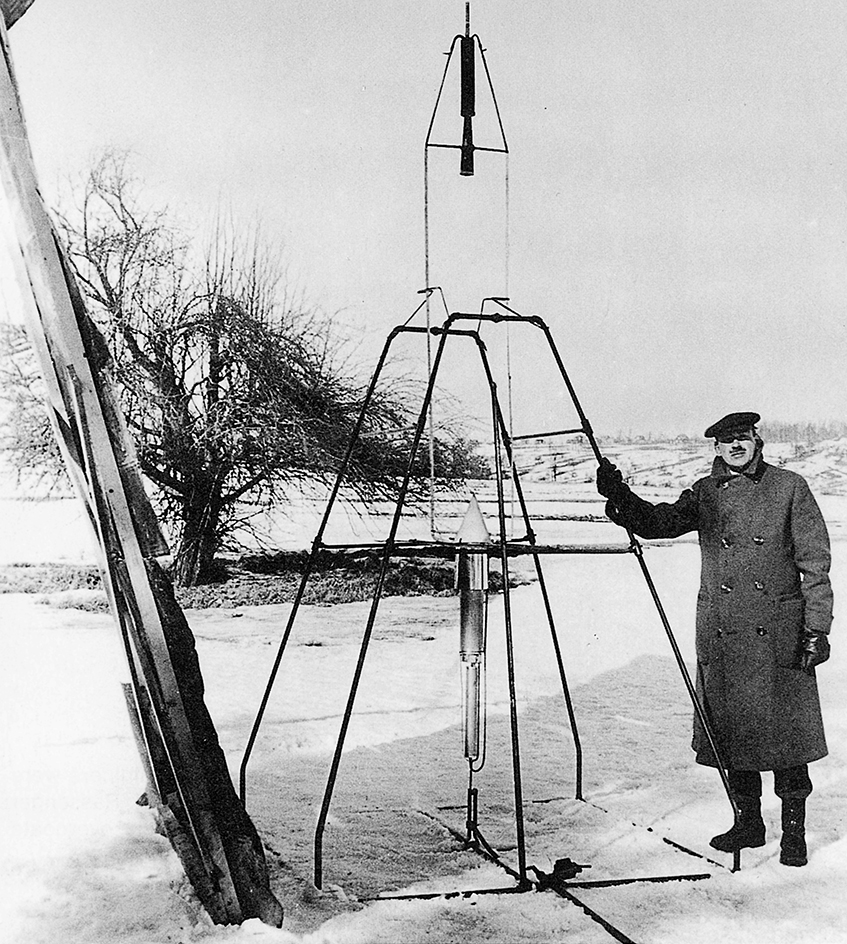
During the 1930’s, rocket research advanced in Germany, the Soviet Union, and the United States. Hermann Oberth led a small group of German engineers and scientists that experimented with rockets. Leading Soviet rocket scientists included Fridrikh A. Tsander and Sergei P. Korolev. Goddard remained the most prominent rocket researcher in the United States.
During World War II, German engineers under the direction of Wernher von Braun developed the powerful V-2 guided missile. Germany bombarded London and Antwerp, Belgium, with hundreds of V-2’s during the last months of the war. American forces captured many V-2 missiles and sent them to the United States for use in research. After the war, von Braun and about 150 other German scientists moved to the United States to continue their work with rockets. Some other German rocket experts went to the Soviet Union.
High-altitude rockets.
For several years after World War II, U.S. scientists benefited greatly by conducting experiments with captured German V-2’s. These V-2’s became the first rockets used for high-altitude research.
The first high-altitude rockets designed and built in the United States included the WAC Corporal, the Aerobee, and the Viking. The 16-foot (4.9-meter) WAC Corporal reached altitudes of about 45 miles (72 kilometers) during test flights in 1945. Early models of the Aerobee climbed about 70 miles (110 kilometers). In 1949, the U.S. Navy launched the Viking, an improved liquid-propellant rocket based chiefly on the V-2. The Viking measured more than 45 feet (14 meters) long, much longer than the Aerobee. But the first models of the Viking rose only about 50 miles (80 kilometers).
Rockets developed by the U.S. armed forces during the 1950’s included the Jupiter and the Pershing. The Jupiter had a range of about 1,600 miles (2,600 kilometers), and the Pershing could travel about 450 miles (720 kilometers).
The U.S. Navy conducted the first successful launch of a Polaris underwater missile in 1960. United States space scientists later used many military rockets developed in the 1950’s as the basis for launch vehicles.
Rocket-powered airplanes.
On Oct. 14, 1947, Captain Chuck Yeager of the U.S. Air Force made the first supersonic (faster than sound) flight. He flew a rocket-powered airplane called the X-1.
A rocket engine also powered the X-15, which set an unofficial airplane altitude record of 354,200 feet (107,960 meters) in 1963. In one flight, the X-15 reached a peak speed of 4,520 miles (7,274 kilometers) per hour—more than six times the speed of sound. A privately owned and developed rocket-powered plane called the EZ-Rocket began piloted test flights in 2001.
The space age
began on Oct. 4, 1957, when the Soviet Union launched the first artificial satellite, Sputnik 1, aboard a two-stage rocket. On Jan. 31, 1958, the U.S. Army launched the first American satellite, Explorer 1, into orbit with a Jupiter-C rocket. 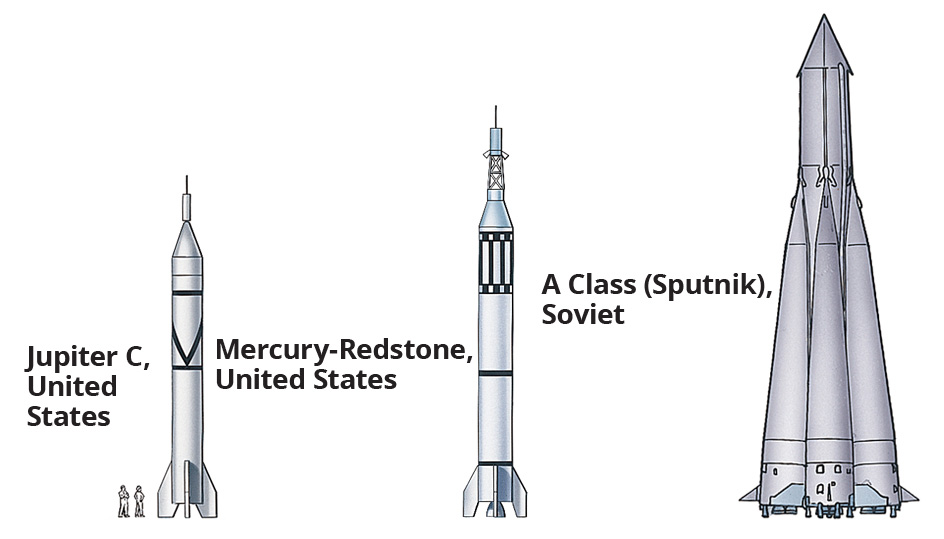
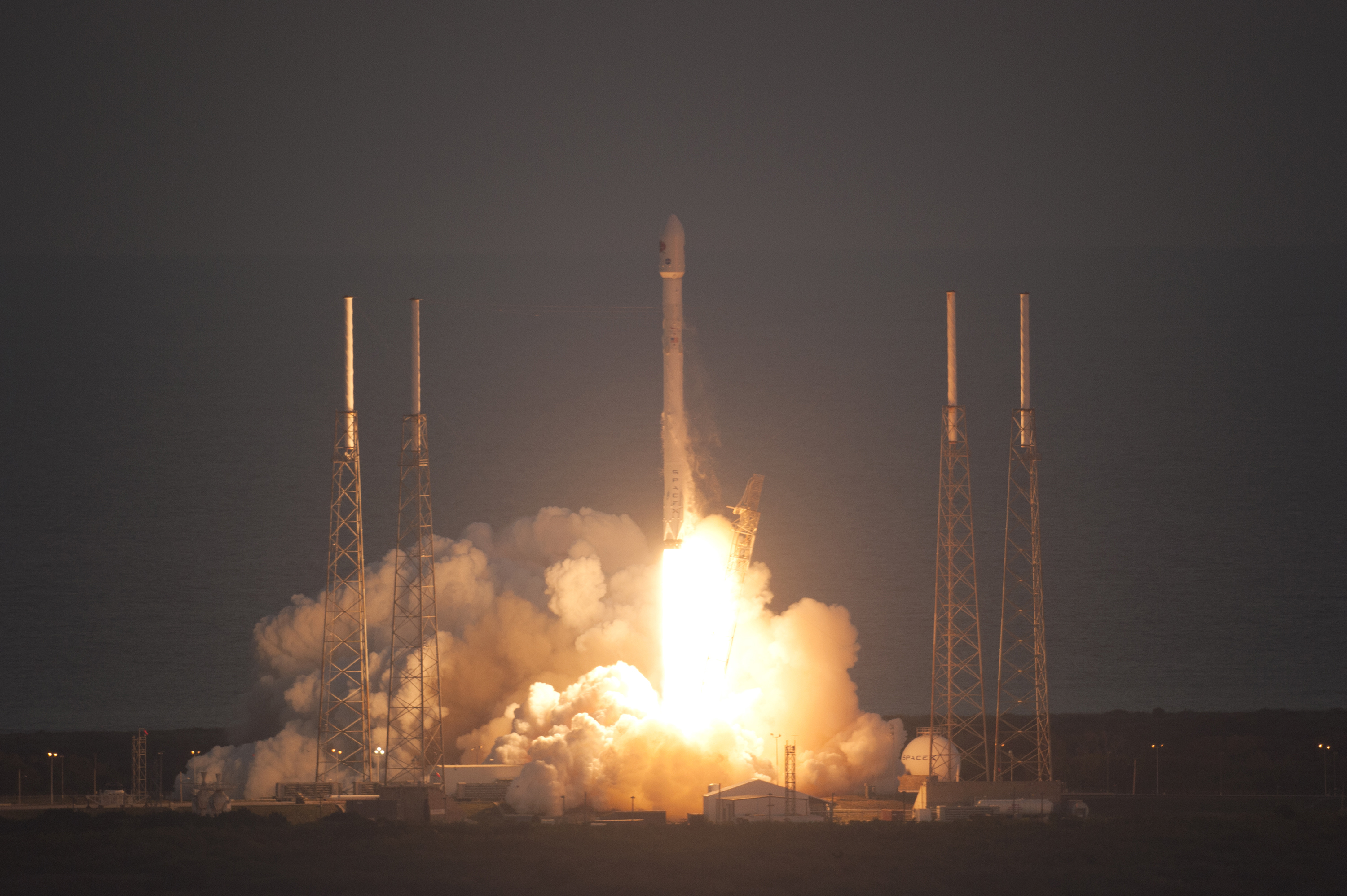
On April 12, 1961, a Soviet rocket put a cosmonaut, Major Yuri A. Gagarin, into orbit around Earth for the first time. On May 5, 1961, a Redstone rocket launched Commander Alan B. Shepard, Jr., the first American to travel in space. On April 12, 1981, the United States launched the rocket-powered Columbia, the first space shuttle to orbit Earth. A private company called SpaceX launched the first commercial orbiting spacecraft in 2010 and launched a spacecraft that reached the International Space Station in 2012. For more information on the history of rockets in space travel, see Space exploration.
Rocket research.
In the early 2000’s, engineers and scientists worked to develop lightweight rocket engines that used safer propellants. They also searched for more efficient propellants that did not require refrigeration. Engineers began designing and testing smaller rocket engines for use in smaller vehicles, such as tiny satellites that may weigh only a few pounds or kilograms when fully loaded.
